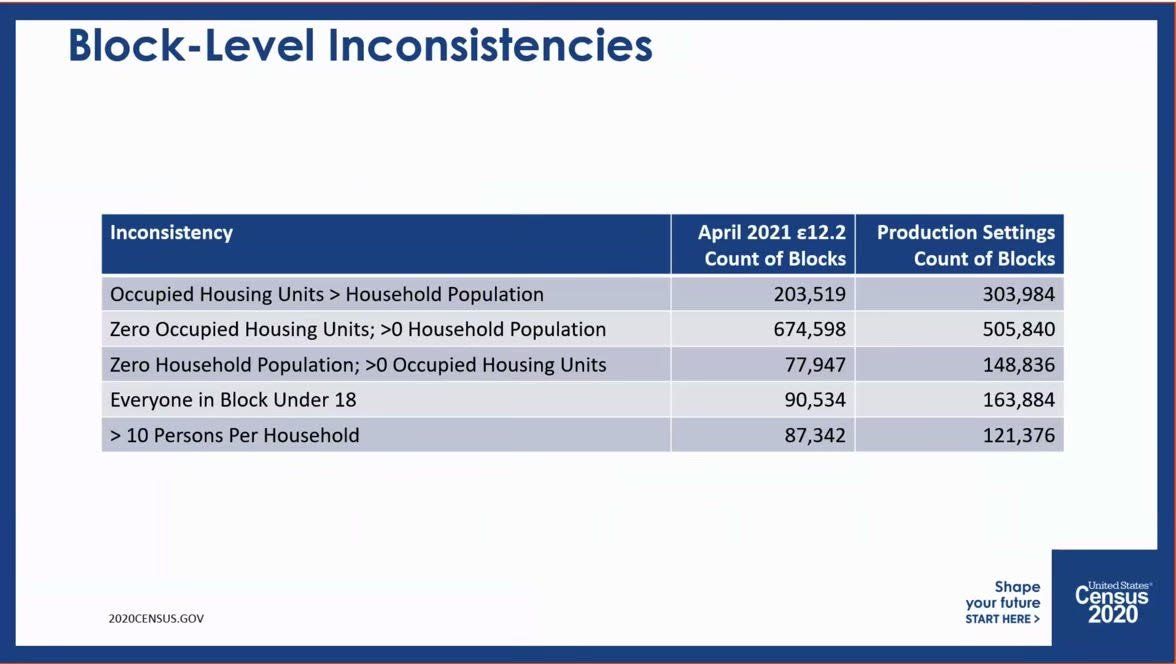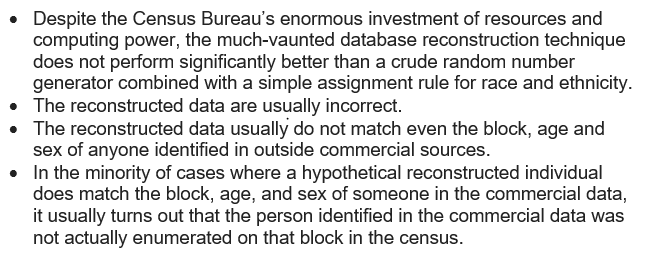
How to get URL link on X (Twitter) App


 The 2020 census faced special challenges stemming from both the pandemic and from Trump’s attempt to add a citizenship question at the last minute. But as @dldmag and I argued, “The greatest concern for the 2020 census is the potential for information technology failure.” 2/4
The 2020 census faced special challenges stemming from both the pandemic and from Trump’s attempt to add a citizenship question at the last minute. But as @dldmag and I argued, “The greatest concern for the 2020 census is the potential for information technology failure.” 2/4

 The Census Bureau plans a new approach to disclosure control for the 2020 census that will add noise to every statistic the agency produces for places below the state level. /2
The Census Bureau plans a new approach to disclosure control for the 2020 census that will add noise to every statistic the agency produces for places below the state level. /2

 The discrepancy is mostly due to one block, where there are no households but 214 persons. The only building on the block is the courthouse, and nobody lives there. /2
The discrepancy is mostly due to one block, where there are no households but 214 persons. The only building on the block is the courthouse, and nobody lives there. /2

https://twitter.com/DataGeekB/status/1402628038244790278According to differential privacy co-inventor @frankmcsherry it means that the Census Bureau privacy protections are pointless.

 These graphs were obtained through a recent FOIA request and appeared in a court filing last week (1:21-cv-01361-ABJ). DRF1 (Decennial Response File 1) is the raw data, and DRF2 has the duplicates removed. Here are the INR graphs for Hispanic Origin and Race. /2
These graphs were obtained through a recent FOIA request and appeared in a court filing last week (1:21-cv-01361-ABJ). DRF1 (Decennial Response File 1) is the raw data, and DRF2 has the duplicates removed. Here are the INR graphs for Hispanic Origin and Race. /2 

 The demonstration data released in April was terrible, as we and others explained.
The demonstration data released in April was terrible, as we and others explained. 

 Newly-published data reveal that the Census Bureau has increased the "noise" added to the data at the block level, compared with the demonstration data released in April./2
Newly-published data reveal that the Census Bureau has increased the "noise" added to the data at the block level, compared with the demonstration data released in April./2
 Liberty Island is considered a block by the Census Bureau, even though it only has two residents. The actual residents of the island were a married couple, who were interviewed by Hanson, aged 59 and 49, who both identified as white./2
Liberty Island is considered a block by the Census Bureau, even though it only has two residents. The actual residents of the island were a married couple, who were interviewed by Hanson, aged 59 and 49, who both identified as white./2
https://twitter.com/frankmcsherry/status/1375939165351776266In my tweets, I was objecting to @john_abowd's characterization of a 45% match rate between his so-called database reconstruction and the actual data on four characteristics as "highly accurate."

 Back on March 10, the State of Alabama filed a lawsuit objecting to the use of differential privacy in the census, arguing that the infusion of deliberate errors into the data is unconstitutional./2
Back on March 10, the State of Alabama filed a lawsuit objecting to the use of differential privacy in the census, arguing that the infusion of deliberate errors into the data is unconstitutional./2

 The new analysis completely misses the point, and actually provides a useful demonstration of the gross misrepresentation of the Census Bureau’s “Database Reconstruction Experiment.” /2
The new analysis completely misses the point, and actually provides a useful demonstration of the gross misrepresentation of the Census Bureau’s “Database Reconstruction Experiment.” /2

 /2. Details of the methodology have not been disclosed, but the idea is to develop models describing the interrelationships of all the variables in the ACS, and then construct a simulated population consistent with those models.
/2. Details of the methodology have not been disclosed, but the idea is to develop models describing the interrelationships of all the variables in the ACS, and then construct a simulated population consistent with those models.

https://twitter.com/SamWangPhD/status/1394880396848943106/2. Abowd states that in tiny blocks, if you “reconstruct” age and it matches someone who lives on the on the block in the commercial database, and then look up the names of those people in the census, the census recorded the same people 72.24% off the time.


 2.I argue that the database reconstruction experiment did not demonstrate a convincing threat to confidentiality, because the results reported by the Census Bureau can be largely explained by chance.
2.I argue that the database reconstruction experiment did not demonstrate a convincing threat to confidentiality, because the results reported by the Census Bureau can be largely explained by chance.
